
For the first post at this blog, I naturally begin with Avengers #4 from March 1964, the first comic in which Captain America appeared after the start of the “Marvel Age” with Fantastic Four #1 in November 1961.
(Cap did “appear” once before this: In Strange Tales #114 from November 1963, the Human Torch met a fake Cap, who was actually the villainous Acrobat in disguise. This story was meant to test the waters for a revival of the real thing—and what a debt of gratitude we owe all the fans who picked up that issue!)
The amazing thing about Avengers #4 is how well Stan Lee and Jack Kirby re-introduce Captain America while establishing his character going forward, especially his new “man out of time” status. As I’ve written elsewhere with respect to the first year of the Fantastic Four, Lee and Kirby establish the key character traits and emotional state of their characters from the beginning, and Avengers #4 is no exception with respect to Captain America.

Before I get to that, though, I have to mention that the reintroduction (via defrosting) of Captain America takes only the first six pages of this comic (not counting the introductory splash page), including his recap of his and Bucky’s final adventure. No six-issue “event” arc of discovery or rebirth (with a zero-issue prologue and extra-priced epilogue). Instead, just a simple “look at what we found—hey, he looks familiar,” after which the Avengers go “missing” and Cap has to find them while acclimating to this strange new world he’s found himself in.
In the context of both his discovery and the ensuing adventure in the last two-thirds of the comic, Lee and Kirby do a fantastic job of reintroducing Captain America to the readers of the mid-60s while also establishing his new status quo. No longer the simplistic patriotic avatar of the 1940s—or the commie-smasher of the 1950s, later retconned to be a different man altogether—he is now firmly established as a “man out of time,” trying to adjust to this strange new world, while also mourning the loss of Bucky and exemplifying traditional virtues in this “modern age.”
“MAN OUT OF TIME” AND GRIEF OVER BUCKY
There are two important aspects of Captain America’s new status quo introduced in this issue: being a “man out of time” and feeling grief (and survivor’s guilt) over losing Bucky. In fact, his young partner’s name is the first thing out of Cap’s mouth once he comes to, flying into a rage before he falls to his knees upon remembering what happened before he fell into the freezing water.
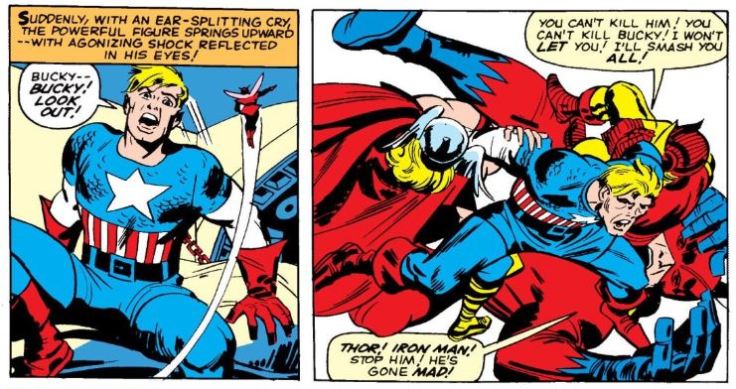

Both Bucky’s death and his two decades as a Capsicle (perpetually lengthened by Marvel’s shifting timeline) combine to produce a man unsure of who he is or how he belongs, as shown in particular in the very revealing second panel below.

Both events together introduce a level of depth to a character who was once all flag-waving bravado, and thereby gives him a psychological “flaw” similar to the newly created Marvel heroes such Spider-Man, Iron Man, and the Hulk. They are also on Cap’s mind during a rare moment of quiet reflection in a hotel (after taking a brief walking tour of New York and being recognized as a long lost hero), during which he questions his purpose and role in this new world, especially without Bucky.

Cap’s rumination is disturbed when Rick Jones, the young friend of the Hulk, storms in to tell him about the missing Avengers. Cap initially mistakes him for Bucky, but even after he realizes the young man is not his former partner, he finds renewed purpose, possibly in the thought of training Rick to be his new sidekick (although he is hesitant to do this in later issues, such as Avengers #7, for fear of putting another young man in danger).


(I don’t remember him taking off the costume, but oh well.)
Although he’s excited now, in time Cap will come to resent the “destiny he can never escape,” especially when it comes to his difficulties maintaining a civilian life—and a romantic one. His existential quandary over being a man out of time, and either not knowing his role or feeling trapped by one being imposed on him, will continue to be a central aspect of his character for decades to come (even as his guilt about Bucky fades, even before he learns about the Winter Soldier and his long hair).
ATHLETIC PROWESS
After his psychological burdens, the aspect of Captain America most emphasized in Avengers #4 is his amazing physical abilities and skill. He first uses them to prove to the Avengers that he is really is the Sentinel of Liberty from World War II…
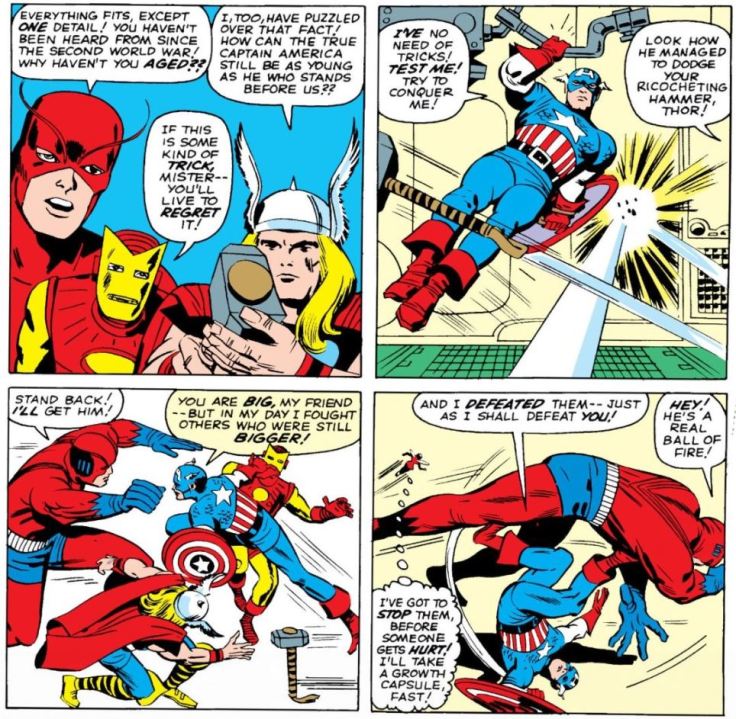
…and then later, when he and Rick find the thugs responsible for the Avengers’ disappearance (who, incidentally, also doubt he’s the real deal).
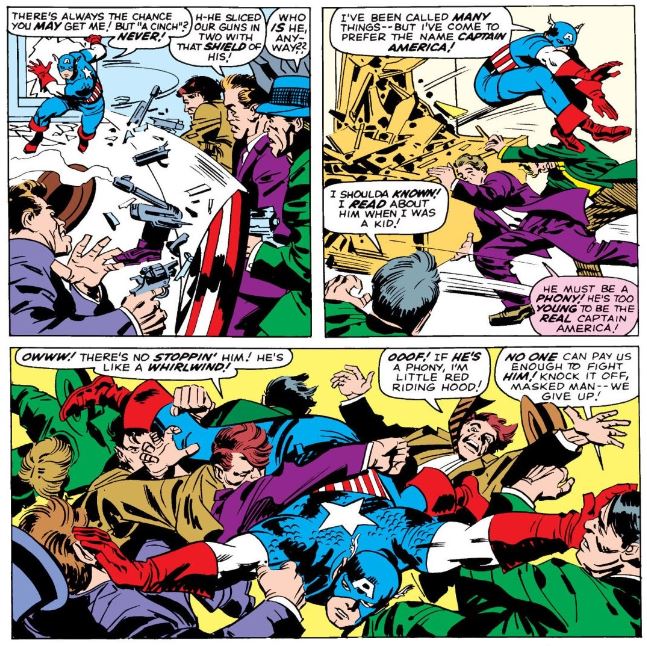
Almost every subsequent issue of Avengers, as well as Cap’s later solo stories in Tales of Suspense, were full of scenes of hand-to-hand combat, posing Cap against groups of thugs or more challenging foes such as Batroc the Leaper. My guess is that Kirby simply loved drawing these scenes, and because none of the other Avengers (or X-Men) were trained in hand-to-hand combat, Cap gave him the chance. (Daredevil and Spider-Man may come closer, but Kirby didn’t draw those heroes regularly.)
You also see that Cap can get very cocky with his repartee when fighting, which is a contrast to his normal humble or stoic speech (except when giving a patented inspirational speech, which he famously doesn’t like doing but oops there he goes again). I prefer to look at these moments as Cap allowing himself to blow off a little steam in a tense situation, which is very welcome for both him and the reader when considered in the context of the existential malaise he’s in for his first several years out of the ice.
A GLIMPSE AT HIS VIRTUES
Of course, Captain America is widely known for his moral virtues. (In fact, someone wrote a book once…) Lee and Kirby don’t emphasize his virtues as much as setting up his new emotional status quo and time-honored fighting ability, but we do see quick glimpses of them. First, his honesty, as he makes a deal with the alien responsible for turning the Avengers into statues.

Courage is another of Cap’s key virtues, but in this issue we see him recognize it in the Avengers instead.
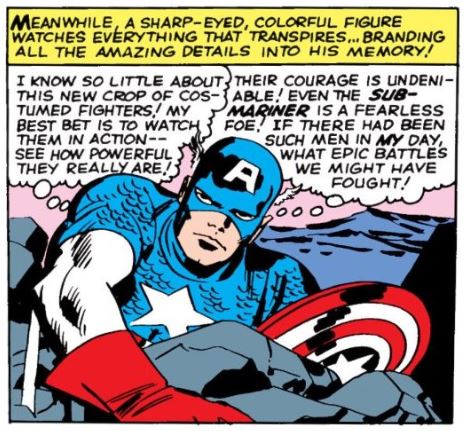
Ironically, it is Iron Man who notes that Cap didn’t join them in the ensuing fight against Namor and his Atlantean soldiers. (“Wait, what?” you ask—I told you a lot happened in this comic.)


We shouldn’t be surprised that in Cap’s first comic back from the deep, Iron Man is already criticizing him—as we’ll soon see, their first battle comes just a few months later in Tales of Suspense #58, and their clashes only become more thoughtful over the decades to come (culminating in the Civil War about which glorious books have been written).
Nonetheless, at the end of the battle (and the issue), the Avengers formally invite Cap to join them, with Cap noting their bravery and Thor acknowledging his honor and dignity. (The “like a man” bit is no surprise, sadly, given how Lee wrote women in the 1960s—see how the Wasp is written in these early Avengers issues, for instance, or how Sue Storm was treated in the early years of the Fantastic Four.)
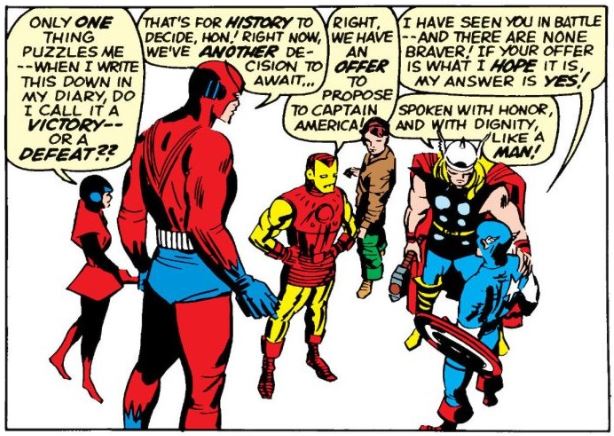
OTHER INTERESTING THINGS OF NOTE
When a police officer sees Cap wondering around Manhattan, marveling at the cars and buildings, he gets misty at seeing a beloved hero return, “just as the world as need of such a man.” This comic was cover-dated March 1964, may have been published earlier and was certainly produced earlier, but I wonder if the officer could be referring to the December 1963 assassination of John F. Kennedy.

And when the alien explains how he used his ray gun to turn the Avengers to stone, Cap hypothesizes the origin of a bit of Greek mythology.

Wait until he finds out the origin of the Norse myths!
ISSUE DETAILS
Avengers (vol. 1) #4, March 1964: Stan Lee and Jack Kirby (words, plot, and pencils), George Roussos (inks), Stan Goldberg (colors), Art Simek (letters). (More details at Marvel Database.)
Collected in: Avengers Epic Collection: Earth’s Mightiest Heroes, Captain America Epic Collection: Captain America Lives Again, Marvel Masterworks: The Avengers Volume One
NEXT ISSUE: Avengers #5 and Fantastic Four #26 (May 1964)
Leave a comment